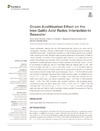Please use this identifier to cite or link to this item:
https://accedacris.ulpgc.es/handle/10553/114071
| Título: | Ocean Acidification Effect on the Iron-Gallic Acid Redox Interaction in Seawater | Autores/as: | Pérez Almeida, María Norma González González, Aridane Santana Casiano, Juana Magdalena González Dávila, Melchor |
Clasificación UNESCO: | 230220 Química microbiológica 2510 Oceanografía |
Palabras clave: | Gallic acid Iron Complexation Redox process Seawater, et al. |
Fecha de publicación: | 2022 | Proyectos: | Our common future ocean in the Earth system ¿ quantifying coupled cycles of carbon, oxygen, and nutrients for determining and achieving safe operating spaces with respect to tipping points Efecto de la Acidificacion Oceanica, la Temperatura y El Contenido de Materia Organica en la Persistencia de Fe(Ii) en El Oceano Atlantico Planificación Conjunta, Seguimiento y Observación, Mejora del Conocimiento y Sensibilización Ante Riesgos y Amezas del Cambio Climatico en la Macaronesia |
Publicación seriada: | Frontiers in Marine Science | Resumen: | Ocean acidification impacts the iron (Fe) biogeochemistry both by its redox and its complexation reactions. This has a direct effect on the ecosystems due to Fe being an essential micronutrient. Polyphenols exudated by marine microorganisms can complex Fe(III), modifying the Fe(II) oxidation rates as well as promoting the reduction of Fe(III) to Fe(II) in seawater. The effect of the polyphenol gallic acid (GA; 3,4,5-trihydroxy benzoic acid) on the oxidation and reduction of Fe was studied. The Fe(II) oxidation rate constant decreased, increasing the permanence of Fe(II) in solutions at nM levels. At pH = 8.0 and in the absence of gallic acid, 69.3% of the initial Fe(II) was oxidized after 10 min. With 100 nM of gallic acid (ratio 4:1 GA:Fe), and after 30 min, 37.5% of the initial Fe(II) was oxidized. Fe(III) is reduced to Fe(II) by gallic acid in a process that depends on the pH and composition of solution, being faster as pH decreases. At pH > 7.00, the Fe(III) reduction rate constant in seawater was lower than in NaCl solutions, being the difference at pH 8.0 of 1.577 × 10–5 s–1. Moreover, the change of the Fe(III) rate constant with pH, within the studied range, was higher in seawater (slope = 0.91) than in NaCl solutions (slope = 0.46). The Fe(III) reduction rate constant increased with increasing ligand concentration, being the effect higher at pH 7.0 [k′ = 1.078 × 10–4 s–1; (GA) = 250 nM] compared with that at pH 8.0 [k′ = 3.407 × 10–5 s–1; (GA) = 250 nM]. Accordingly, gallic acid reduces Fe(III) to Fe(II) in seawater, making possible the presence of Fe(II) for longer periods and favoring its bioavailability. | URI: | https://accedacris.ulpgc.es/handle/10553/114071 | ISSN: | 2296-7745 | DOI: | 10.3389/fmars.2022.837363 | Fuente: | Frontiers in Marine Science [ISSN 2296-7745], v. 9, 837363, (Febrero 2022) |
| Colección: | Artículos |
Citas SCOPUSTM
12
actualizado el 08-jun-2025
Citas de WEB OF SCIENCETM
Citations
10
actualizado el 08-jun-2025
Visitas
147
actualizado el 23-nov-2024
Descargas
124
actualizado el 23-nov-2024
Google ScholarTM
Verifica
Altmetric
Comparte
Exporta metadatos
Los elementos en ULPGC accedaCRIS están protegidos por derechos de autor con todos los derechos reservados, a menos que se indique lo contrario.
